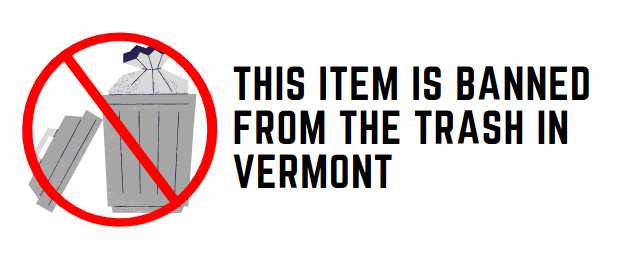LIGHTBULBS -
CFLs, FLUORESCENT & OTHER MERCURY CONTAINING
DISPOSAL INFO
Fluorescent light bulbs containing mercury, a hazardous substance. They are banned from the trash in Vermont. They are accepted at all LRSWMD drop-off stations.
A. Compact fluorescent lamps (CFLs)
This includes fluorescent bulbs with screw-in bases in a number of shapes, and pin-base CFLs.
B. Other general mercury-containing lamps
Straight, circular and U-shaped fluorescent tubes, HID (high intensity discharge) bulbs.
In addition to our sites, there are over 100 retail collection sites for fluorescent bulbs throughout the state. Visit LampRecycle.org to find other locations near you. Limitations may apply.
For info on how to dispose of non-fluorescent bulbs, see here.
COSTS
A. CFLs
Any quantity, free
B. Other general mercury-containing lamps
Straight, circular, and U-shaped tubes (up to 10 items): FREE
Straight, circular, and U-shaped tubes (11 or more items): 7 cents per foot
FLUORESCENT LIGHT BULBS, Image source: https://cswd.net/a-to-z/fluorescent-lamps/
If you break a mercury-containing light bulb :
Do not vacuum or sweep the area as it will spread mercury vapor to other areas of the room. Also, keep all people and pets away from breakage area so that mercury powder is not tracked into other areas.
For breakage on a hard surface:
Ventilate the area well by closing interior doors and vents, opening windows and any exterior doors in the room, and leaving the room for at least 15 minutes.
Remove all materials you can and do not vacuum or sweep.
Wear disposable gloves, if available.
Carefully scoop up glass fragments and dust with a stiff piece of paper or cardboard (such as playing cards or index cards).
Pick up any remaining small pieces of glass and powder using sticky tape (such as masking tape or duct tape).
Wipe the area clean with a damp paper towel or disposable wet wipe.
Place all cleanup materials (cardboard, gloves, tape, etc.) in a plastic bag (and double bag) to seal it; or preferably, place into a glass or rigid container with a lid. Store the bag or container outside of the house in an area inaccessible to children.
Wash your hands.
Bring to the District Transfer Station during household hazardous waste hours.
Leave the windows in the affected room or area open as long as practical (weather permitting).
For breakage on carpet, complete steps 1 through 6 above, then:
If rug is removable, take it outside, shake, and air out as long as practical.
After cleanup and the room or area has been ventilated: the first time you vacuum the area where the bulb was broken, shut the door to the room or close off the area from as much of the rest of the house as possible, and ventilate the room when vacuuming. Remove the vacuum bag once done cleaning the area, wipe vacuum with wet wipe and put the bag and/or vacuum debris, including cleanup materials, into a plastic bag (double bag it) and store the bag outside the house in an area inaccessible to children. Refer to #5 above for proper disposal options.
After vacuuming, keep window open, door closed and children/pets out of room.
Consider removal of carpeting section where the breakage has occurred as a precaution when there are infants, small children, and pregnant women present.
For questions, call the Vermont Department of Health at (802) 240-5076 (24 hour pager).
Source: https://www.addisoncountyrecycles.org/guide/mercury-containing-light-bulbs-lamps

